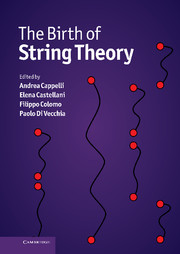Book contents
- Frontmatter
- Contents
- List of contributors
- Photographs of contributors
- Preface
- Abbreviations and acronyms
- Part I Overview
- EARLY STRING THEORY
- Part II The prehistory: the analytic S-matrix
- Part III The Dual Resonance Model
- Part IV The string
- TOWARDS MODERN STRING THEORY
- Part V Beyond the bosonic string
- Part VI The superstring
- 35 Introduction to Part VI
- 36 Supersymmetry in string theory
- 37 Gravity from strings: personal reminiscences of early developments
- 38 From the Nambu–Goto to the σ-model action
- 39 Locally supersymmetric action for the superstring
- 40 Personal recollections
- 41 The scientific contributions of Joël Scherk
- Part VII Preparing the string renaissance
- Appendix A Theoretical tools of the Sixties
- Appendix B The Veneziano amplitude
- Appendix C From the string action to the Dual Resonance Model
- Appendix D World-sheet and target-space supersymmetry
- Appendix E The field theory limit
- Index
38 - From the Nambu–Goto to the σ-model action
from Part VI - The superstring
Published online by Cambridge University Press: 05 May 2012
- Frontmatter
- Contents
- List of contributors
- Photographs of contributors
- Preface
- Abbreviations and acronyms
- Part I Overview
- EARLY STRING THEORY
- Part II The prehistory: the analytic S-matrix
- Part III The Dual Resonance Model
- Part IV The string
- TOWARDS MODERN STRING THEORY
- Part V Beyond the bosonic string
- Part VI The superstring
- 35 Introduction to Part VI
- 36 Supersymmetry in string theory
- 37 Gravity from strings: personal reminiscences of early developments
- 38 From the Nambu–Goto to the σ-model action
- 39 Locally supersymmetric action for the superstring
- 40 Personal recollections
- 41 The scientific contributions of Joël Scherk
- Part VII Preparing the string renaissance
- Appendix A Theoretical tools of the Sixties
- Appendix B The Veneziano amplitude
- Appendix C From the string action to the Dual Resonance Model
- Appendix D World-sheet and target-space supersymmetry
- Appendix E The field theory limit
- Index
Summary
Introduction
My generation of string theorists was very fortunate. We were there when the first ideas leading up to string theory were proposed, and we were young and inexperienced enough not to ask too deep questions. We could accept working in 26 dimensions of spacetime, even when more experienced people laughed at it (and us). We were not more clever than they were, not at all, rather we became so attached to the ideas that we did not listen to good advice. The average age of the active people was probably well under thirty, and it was one of the rare occasions where a young generation could form its scientific future. There were a number of older heroes, most notably Yoichiro Nambu, Stanley Mandelstam, Sergio Fubini and Daniele Amati. Also, the leading theoretical physicist of those days, Murray Gell-Mann, was sympathetic. His words, always carefully phrased, were listened to by everyone in particle physics. This blend made the field so exciting that once hooked it was difficult to leave it. After some years many had to change field in order to find positions, but most of us had the secret wish to return to this subject.
The formative years
I started as a graduate student in 1967. Sweden still had the old system, which meant that there were no graduate schools. You had to study on your own, and you had to work on your own.
- Type
- Chapter
- Information
- The Birth of String Theory , pp. 474 - 483Publisher: Cambridge University PressPrint publication year: 2012
- 1
- Cited by



